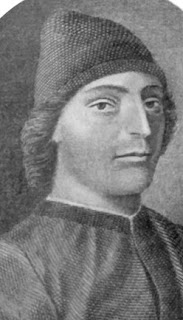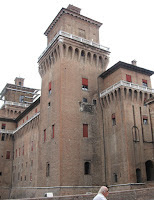Polymath was also a gambler and womaniser
 |
Girolamo Cardano was the leading
mathematician of Renaissance Italy |
The Renaissance polymath Girolamo Cardano, whose range of talents included mathematics and medicine but who also invented a number of mechanical devices still in use today, was born on this day in 1501 in Pavia, then part of the Duchy of Milan.Cardano, also known as Gerolamo, Hieronymus Cardanus in Latin and Jerome Cardan in English, is notable for writing Ars Magna which was the first Latin treatise devoted solely to algebra.
Far from being a stuffy academic, however, Cardano led a controversial life, practising as a physician without a licence and becoming proficient at gambling to keep himself solvent, while as a university professor being regularly accused of sexual impropriety with students.
In his wide range of interests, he seemed to be inspired by Leonardo da Vinci, who was a close friend of his father. Like Da Vinci, he wanted to put his mathematical and scientific skills to practical use and is credited with inventing among other things the first combination locks, the gimbal that allows a supported compass or gyroscope to rotate freely, and a universal joint that allows the transmission of rotation between the components of a drive train even when out of alignment.
A version of the joint in use today to connect the gearbox of a rear-wheel drive car with the rear axle is called a Cardan Shaft.
Girolamo Cardano was the illegitimate child of Fazio Cardano, a Milanese lawyer and university professor, and Chiara Micheria, a widow 20 years Fazio’s junior. Despite his mother’s attempts to abort the pregnancy, Girolamo was born at the home of some wealthy friends of his father in Pavia, where his mother was sent to escape an outbreak of plague in Milan that claimed the lives of her three other children.
 |
The cover page of Ars Magna, seen
as Cardano's magnum opus |
Girolamo survived a sickly childhood and, fascinated with philosophy and science, enrolled to read medicine at the
University of Pavia, against the wishes of his father, who wanted him to study law. The Italian War of 1521-26 forced the University of Pavia to close but he was able to resume his studies at the
University of Padua.There, however, he gained a reputation for being awkward and confrontational and while he obtained a doctorate he was denied admission to the College of Physicians in Milan, partly because he was not well liked and partly because of his illegitimacy.
Unable to practise medicine legally in Milan, he moved to Saccolongo, a village outside Padua where he set up a practice despite his lack of a licence. He married Lucia, the daughter of a local militia captain, with whom he had three children. His practice was not particularly successful, however, and he increasingly turned to gambling to make money, a habit he had developed while studying, but slipped further into debt.
Desperate for a change of fortune, he moved the family back to Milan. They had so little money they were forced to live in a poorhouse but Girolamo eventually elicited help from contacts of his father in the Milanese nobility, who arranged for him to be given his father’s former post of lecturer in mathematics at the Piatti Foundation in Milan.
For all that he was a difficult character, his brilliant mind was never in doubt and when the College of Physicians changed their attitude to illegitimacy he was granted his licence. His success in treating his patients, some of whom had wide influence in Milan society, soon made him the most sought-after doctor in the city.
 |
Cardano's universal joint is still used in the
drive shafts of motor vehicles today |
The next few years were his most productive. In 1537, he published the first of some 130 printed works, the most famous of which was
Ars Magna, published in 1545. It included the first comprehensive solution for finding roots of cubic equations, which at the time was a subject that was the focus of much attention. Even that was the subject of controversy as
Nicolo Tartaglia, another mathematician of note, accused Cardano of publishing results shared with him in confidence.
He also wrote Liber de ludo aleae - Book on Games of Chance - which contains the first systematic treatment of probability, the basic concepts of which he had learned through his gambling. He also shared some of his secrets on how to cheat successfully.
Cardano did much of his inventing during this period, and enhanced his reputation as one of the world’s finest physicians, becoming rector of the College of Physicians that for so long rejected him.
He turned down most invitations to work outside Italy but made an exception when asked to travel to Scoland, where John Hamilton, Archbishop of St Andrews, was suffering increasingly severe asthma attacks that the physicians of both the French king and German emperor had been unable to keep in check.
 |
Cardano was also known for his chaotic
and controversial personal life |
Cardano was welcomed as a celebrity when he landed in Scotland, where he was promised a substantial payment if he could treat the Archbishop successfully. In the event, he quickly established that feather pillows were the cause of the Archbishop’s malady and the patient made a full recovery.
For all that he was ultimately hailed as a genius, Cardano's personal life was filled with tragedy.
Lucia died in 1546, his eldest son was executed for poisoning his wife and his daughter died of syphilis. He disowned his second son, who stole money from him to fund his own gambling addiction.
Cardano was appointed a professor of medicine at the University of Bologna but as the father of a convicted murderer he was shunned by many colleagues, while his arrogant manner made him many enemies. A shameless womaniser, he was frequently accused of using his power to coerce female students into inappropriate relationships.
In 1570 he spent a short time in jail, having been accused of heresy after publishing a horoscope of Jesus Christ. It cost him his position at the University of Bologna.
Nonetheless, on moving to Rome he received a lifetime annuity from Pope Gregory XIII and was accepted in the Royal College of Physicians. He continued to practise medicine and expanded his philosophical studies.
He died in Rome in 1576 at the age of 74.
 |
The covered bridge linking Pavia with the
area known as Borgo Ticino |
Travel tip:Pavia is a city in Lombardy, about 46km (30 miles) south of Milan. Its university was founded in 1361 and was the sole university in the Duchy of Milan until the 19th century. As well as Girolamo Cardano, its alumni include explorer Christopher Columbus, physicist Alessandro Volta and the poet and revolutionary Ugo Foscolo. Pavia is also famous for its Certosa, a magnificent Renaissance monastery complex north of the city that dates back to 1396 and includes a number of important sculptures and frescoes. A pretty covered bridge over the River Ticino leads to Borgo Ticino, where the inhabitants claim to be the true people of Pavia.
 |
Giotto's frescoes cover the inner
walls of the Scrovegni Chapel |
Travel tip:Padua in the Veneto is one of the most important centres for art in Italy and home to the country’s second oldest university. Padua has become acknowledged as the birthplace of modern art because of the Scrovegni Chapel, the inside of which is covered with frescoes by Giotto, an artistic genius who was the first to paint people with realistic facial expressions showing emotion. His scenes depicting the lives of Mary and Joseph, painted between 1303 and 1305, are considered his greatest achievement and one of the world’s most important works of art. At Palazzo Bo, where Padua’s university was founded in 1222, you can still see the original lectern used by Galileo and the world’s first anatomy theatre, where dissections were secretly carried out from 1594.
Also on this day:
1934: The birth of exiled Princess Maria Pia of Bourbon-Parma
1954: The birth of footballer Marco Tardelli
1955: The birth of businessman Riccardo Illy
Home






































